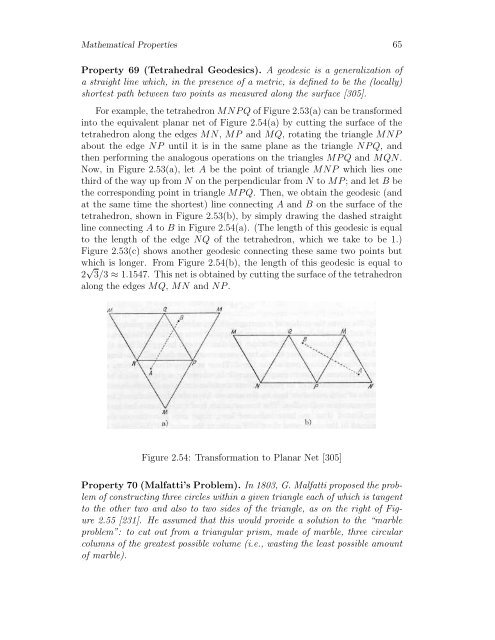MYSTERIES OF THE EQUILATERAL TRIANGLE - HIKARI Ltd
MYSTERIES OF THE EQUILATERAL TRIANGLE - HIKARI Ltd
MYSTERIES OF THE EQUILATERAL TRIANGLE - HIKARI Ltd
You also want an ePaper? Increase the reach of your titles
YUMPU automatically turns print PDFs into web optimized ePapers that Google loves.
Mathematical Properties 65<br />
Property 69 (Tetrahedral Geodesics). A geodesic is a generalization of<br />
a straight line which, in the presence of a metric, is defined to be the (locally)<br />
shortest path between two points as measured along the surface [305].<br />
For example, the tetrahedron MNPQ of Figure 2.53(a) can be transformed<br />
into the equivalent planar net of Figure 2.54(a) by cutting the surface of the<br />
tetrahedron along the edges MN, MP and MQ, rotating the triangle MNP<br />
about the edge NP until it is in the same plane as the triangle NPQ, and<br />
then performing the analogous operations on the triangles MPQ and MQN.<br />
Now, in Figure 2.53(a), let A be the point of triangle MNP which lies one<br />
third of the way up from N on the perpendicular from N to MP; and let B be<br />
the corresponding point in triangle MPQ. Then, we obtain the geodesic (and<br />
at the same time the shortest) line connecting A and B on the surface of the<br />
tetrahedron, shown in Figure 2.53(b), by simply drawing the dashed straight<br />
line connecting A to B in Figure 2.54(a). (The length of this geodesic is equal<br />
to the length of the edge NQ of the tetrahedron, which we take to be 1.)<br />
Figure 2.53(c) shows another geodesic connecting these same two points but<br />
which is longer. From Figure 2.54(b), the length of this geodesic is equal to<br />
2 √ 3/3 ≈ 1.1547. This net is obtained by cutting the surface of the tetrahedron<br />
along the edges MQ, MN and NP.<br />
Figure 2.54: Transformation to Planar Net [305]<br />
Property 70 (Malfatti’s Problem). In 1803, G. Malfatti proposed the problem<br />
of constructing three circles within a given triangle each of which is tangent<br />
to the other two and also to two sides of the triangle, as on the right of Figure<br />
2.55 [231]. He assumed that this would provide a solution to the “marble<br />
problem”: to cut out from a triangular prism, made of marble, three circular<br />
columns of the greatest possible volume (i.e., wasting the least possible amount<br />
of marble).

















